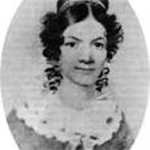Henry Rowe Schoolcraft was most famous for his work as an ethnologist and Indian Agent. He pursued a number of careers during his lifetime, including glassmaker, geologist, explorer, and author. He was born in Guilderland, Albany County, New York, on March 28, 1793.
In 1822, at the age of 29, Schoolcraft was appointed Indian Agent for the Northwest Territory. He arrived in Sault Sainte Marie with Colonel Hugh Brady and his troop of 250 officers and men in July of 1822 to establish a fort and Indian Agency.
Aware of the difficulties he faced due to his ignorance of the Chippewa language and the inability to communicate, even with the interpreters, Schoolcraft actively sought to expand his knowledge by studying the language and preparing an “Ojibway Dictionary”. Mr. Johnston’s wife, Susan (Oshahguscodaywayquay), who was a Chippewa Indian, was extremely helpful to Schoolcraft in his study of Indian languages and culture.
The bond that developed between Schoolcraft and the Johnston family became even closer with his marriage to Jane (Bamewawagezihkaquay), John Johnston’s eldest daughter. The wedding was a quiet family affair, which took place in front of the Johnston’s fireplace on October 12, 1834 and was led by Rev. R.M. Laird. Before the wedding, John Johnston added a comfortable suite of rooms to his home for the newlyweds. This portion of the house still exists today.
As Indian Agent, Schoolcraft’s responsibilities included: handling appeals from Indians looking for assistance; preventing problems generated by drunken behavior; controlling the trade of contraband liquor to the Indians; licensing traders permitted to trade with the Indians; initiating efforts to civilize and educate the Indians, and preventing hostilities between the different tribes over disputed boundaries and longtime feuds. Besides dealing with the Indians in the Sault, Schoolcraft frequently traveled to monitor conditions in his vast district. Other aspects of his duties requiring him to travel included the negotiating of treaties to settle boundary disputes between the Sioux and the Chippewa during the years from 1825 and 1827. Because hostilities continued, additional trips for treaty negotiating were needed in 1830 and 1831.
On these trips, Schoolcraft interviewed Indians and gathered information on their customs. He also studied the geology and natural science of the areas he visited and shared this information with prominent government leaders and scientists alike. Schoolcraft published several books based on his travels and research.
Schoolcraft and his family remained in the Sault until 1833 when the Indian Agency moved to Mackinac Island. Schoolcraft resigned in 1841 and moved to New York. Shortly after arriving there, his wife Jane died unexpectedly. Schoolcraft maintained an interest in Indian culture and continued to research other tribes and to publish his findings. After 1857, Schoolcraft wrote no more, due to crippling rheumatism. He died on December 10, 1864.

